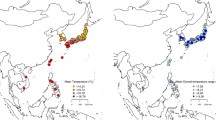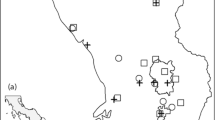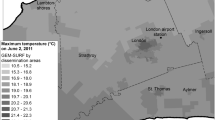Abstract
A variety of ambient exposure indicators have been used to evaluate the impact of high temperature on mortality and in the identification of susceptible population sub-groups, but no study has evaluated how airport and city centre temperatures differ in their association with mortality during summer. This study considers the differences in temperatures measured at the airport and in the city centre of three Italian cities (Milan, Rome and Turin) and investigates the impact of these measures on daily mortality. The case-crossover design was applied to evaluate the association between daily mean apparent temperature (MAT) and daily total mortality. The analysis was conducted for the entire population and for subgroups defined by demographic characteristics, socioeconomic status and chronic comorbidity (based on hospitalisation during the preceding 2 years). The percentage risk of dying, with 95% confidence intervals (95% CI), on a day with MAT at the 95th percentile with respect to the 25th percentile of the June–September daily distribution was estimated. Airport and city-centre temperature distributions, which vary among cities and between stations, have a heterogeneous impact on mortality. Milan was the city with the greatest differences in mean MAT between airport and city stations, and the overall risk of dying was greater when airport MAT (+47% increase, 95%CI 38–57) was considered in comparison to city MAT (+37% increase, 95%CI 30–45). In Rome and Turin, the results were very similar for both apparent temperature measures. In all cities, the elderly, women and subjects with previous psychiatric conditions, depression, heart and circulation disorders and cerebrovascular disease were at higher risk of dying during hot days, and the degree of effect modification was similar using airport or city-centre MAT. Studies on the impact of meteorological variables on mortality, or other health indicators, need to account for the possible differences between airport and city centre meteorological variables in order to give more accurate estimates of health effects.



Similar content being viewed by others
Notes
Tapp= -2.653 + 0.994Ta + 0.0153(Td2)
References
Alberdi J, Diaz J, Montero J, Miron I (1998) Daily mortality in Madrid community 1986–1992: relationship with meteorological variables. Eur J Epidemiol 14:571–578
Ballester F, Corella D, Perez-Hoyos S, Saez M, Hervas A (1997) Mortality as a function of temperature. A study in Valencia, Spain, 1991–1993. Int J Epidemiol 26:551–561
Basu R, Samet JM (2002a) Relation between elevated ambient temperature and mortality: a review of the epidemiologic evidence. Epidemiol Rev 24:190–202
Basu R, Samet JM (2002b) An exposure assessment study of ambient heat exposure in an elderly population in Baltimore, Maryland. Environ Health Perspect 110:1219–1224
Biggeri A, Bellini P, Terracini B (2004) Metanalisi italiana degli studi sugli effetti a breve termine dell’inquinamento atmosferico 1996–2002. Epidemiol Prev 28[Suppl]:1–100
Braga ALF, Zanobetti A, Schwartz J (2001) The time course of weather-related deaths. Epidemiology 12:662–667
Braga ALF, Zanobetti A, Schwartz J (2002) The effect of weather on respiratory and cardiovascular deaths in 12 U.S. cities. Environ Health Perspect 110:859–863
Cesaroni G, Agabiti N, Forastiere F, Ancona C, Perucci CA (2006) Socioeconomic differentials in premature mortality in Rome: changes from 1990 to 2001. BMC Public Health 2:270, DOI 10.1186/1471-2458-6-270
Curriero FC, Heiner KS, Samet JM, Zeger SL, Strug L, Patz JA (2002) Temperature and mortality in eleven cities of the Eastern United States. Am J Epidemiol 155:80–87
Diaz J, Garcia R, Velazquez de Castro F, Hernandez E, Lopez C, Otero A (2002) Effects of extremely hot days on people older than 65 years in Seville (Spain) from 1986 to 1997. Int J Biometeorol 46:145–149
Elixhauser A, Steiner C, Harris DR, Coffey RM (1998) Comorbidity measures for use with administrative data. Med Care 36:8–27
Hafner J, Kidder SQ (1999) Urban heat island modeling in conjunction with satellite-derived surface/soil parameters. J Appl Meteorol 38:448–465
Hajat S, Kovats RS, Atkinson RW, Haines A (2002) Impact of hot temperatures on death in London: a time series approach. J Epidemiol Community Health 56:367–372
Hastie TJ, Tibshirani NJ (1990) Generalized additive models, vol 43. Chapman & Hall, New York, NY
Huynen M, Martens P, Schram D, Weijenberg MP, Kunst AE (2001) The impact of heat waves and cold spells on mortality rates in the Dutch population. Environ Health Perspect 109:463–470
Kalkstein LS, Valimont KM (1986) An evaluation of summer discomfort in the United States using a relative climatological index. Bull Am Meteorol Soc 67:842–848
Katsouyanni K, Touloumi G, Spix C, Schwartz J, Balducci F, Medina S, Rossi G, Wojtyniak B, Sunyer J, Bacharova L, Schouten JP, Ponka A, Anderson HR (1997) Short term effects of ambient sulphur dioxide and particulate matter on mortality in 12 European cities: results from time series data from the APHEA project. BMJ 314:1658–1663
Koppe K, Jendritsky G (2005) Inclusion of short-term adaptation to thermal stresses in a heat load warning procedure. Meteorol Z 14:271–278
Kovats SR, Hajat S, Wilkinson P (2004) Contrasting patterns of mortality and hospital admissions during hot weather and heat waves in greater London, UK. Occup J Environ Med 61:893–898
Krieger N, Chen JT, Waterman PD, Soobader MJ, Subramanian SV, Carson R (2002) Geocoding and monitoring of US socioeconomic inequalities in mortality and cancer incidence: does the choice of area-based measure and geographic level matter?: the Public Health Disparities Geocoding Project. Am J Epidemiol 156:471–482
Kyselý J (2004) Mortality and displaced mortality during heat waves in the Czech Republic. Int J Biometeorol 49:91–97
Levy L, Lumley T, Sheppard L, Kaufman J, Checkoway H (2001) Referent selection in case-crossover analyses of acute health effects of air pollution. Epidemiology 12:186–192
Maclure M (1991) The case-crossover design: a method for studying transient effects on the risk of acute events. Am J Epidemiology 133:144–537
Michelozzi P, de’Donato F, Accetta G, Forastiere F, D’Ovidio M, Perucci C, Kalkstein LS (2004) Impact of heat waves on mortality—Rome, Italy, June–August 2003. MMWR 53:369–371
Michelozzi P, de’ Donato F, Bisanti L, Russo A, Cadum E, DeMaria M, D’Ovidio M, Costa G, Perucci CA (2005) The impact of the summer 2003 heat waves on mortality in four Italian cities. Eur Surveill 10:161–165
Michelozzi P, De Sario M, Accetta G, de’Donato F, Kirchmayer U, D’Ovidio M, Perucci CA, the HHWWS Collaborative Group (2006) Temperature and summer mortality: geographical and temporal variations in four Italian cities. Epidemiol Community Health 60:417–423
Muggeo VMR (2003) Estimating regression models with unknown break-points. Stat Med 22:3055–3071
Naughton MP, Henderson A, Mirabelli M, Kaiser R, Wilhelm JL, Kieszak SM, Rubin CH, McGeehin MA (2002) Heat-related mortality during a 1999 heat wave in Chicago. Am J Prev Med 22:221–227
O’Neill MS, Zanobetti A, Schwartz J (2003) Modifiers of the temperature and mortality associations in seven US cities. Am J Epidemiol 157:1074–1082
Rooney C, McMichael AJ, Kovats RS, Coleman MP (1998) Excess mortality in England and Wales, and in Greater London, during the 1995 heatwave. J Epidemiol Community Health 52:482–486
Samet JM, Dominici F, Curriero FC, Coursac I, Zeger SL (2000) Fine particulate air pollution and mortality in 20 U.S. cities, 1987–1994. N Engl J Med 343:1742–1749
Schwartz J (2005) Who is sensitive to extreme of temperature—a case-only analysis. Epidemiology 16:67–72
Semenza JC, Rubin CH, Falter KH, Selanikio JD, Flanders WD, Howe HL, Wilhelm JL (1996) Heat-related deaths during the July 1995 heat wave in Chicago. N Engl J Med 335:84–90
Smoyer KE (1998) A comparative analysis of heat waves and associated mortality in St. Louis, Missouri—1980 and 1995. Int J Biometeorol 42:44–50
Smoyer-Tomic K, Rainham D (2001) Beating the heat: development and evaluation of a Canadian hot weather health-response plan. Environ Health Perspect 109:1241–1248
Stafoggia M, Forastiere F, Agostini D, Biggeri A, Bisanti L, Cadum E, Caranci N, de’ Donato F, De Lisio S, De Maria M, Michelozzi P, Miglio R, Pandolfi P, Picciotto S, Rognoni M, Russo A, Scarnato C, Perucci CA (2006) Vulnerability to heat-related mortality: a multi-city population-based case-crossover analysis. Epidemiology 17:315–323
Stafoggia M, Forastiere F, Agostini D, Caranci N, de’Donato F, Demaria M, Michelozzi P, Miglio R, Rognoni M, Russo A, Perucci CA (2007) Factors affecting in-hospital heat-related mortality: a multi-city case-crossover analysis. J Epidemiol Community Health (in press)
The R Foundation for Statistical Computing (2004) Version 2.1.0 (2005-04-19), http://cran.r-project.org
Voogt JA, Oke TR (2003) Thermal remote sensing of urban climates. Remote Sens Environ 86:370–384
Weisskopf M, Anderson H, Foldy S, Hanrahan LP, Blair K, Torok TJ, Rumm PD (2002) Heat wave morbidity and mortality, milwaukee, wis, 1999 vs 1995: an improved response? Am J Public Health 92:830–833
Wood SN (2000) Modelling and smoothing parameter estimation with multiple quadratic penalties. J R Stat Soc B 62:413–428
Author information
Authors and Affiliations
Corresponding author
Rights and permissions
About this article
Cite this article
de’Donato, F.K., Stafoggia, M., Rognoni, M. et al. Airport and city-centre temperatures in the evaluation of the association between heat and mortality. Int J Biometeorol 52, 301–310 (2008). https://doi.org/10.1007/s00484-007-0124-5
Received:
Revised:
Accepted:
Published:
Issue Date:
DOI: https://doi.org/10.1007/s00484-007-0124-5




